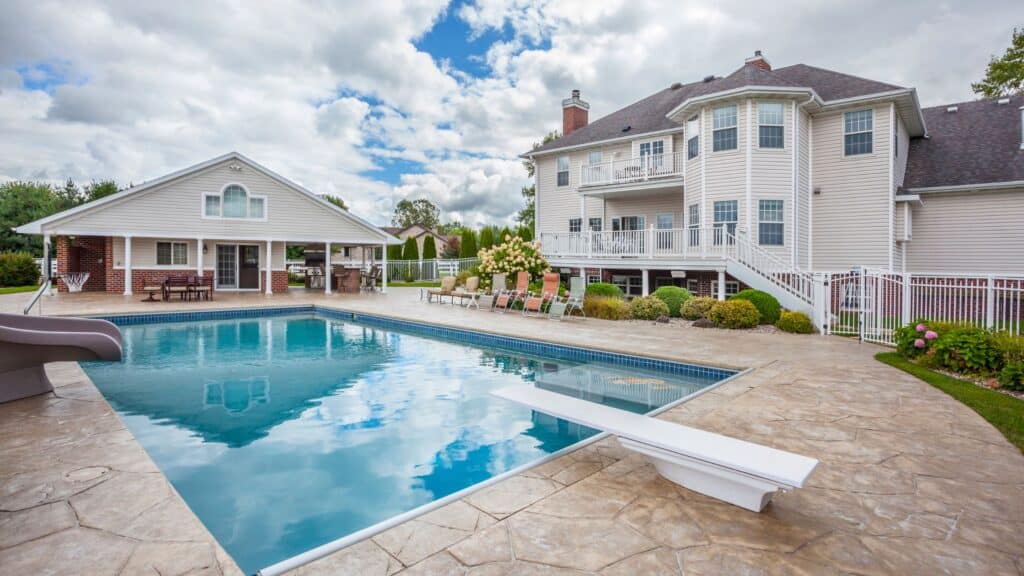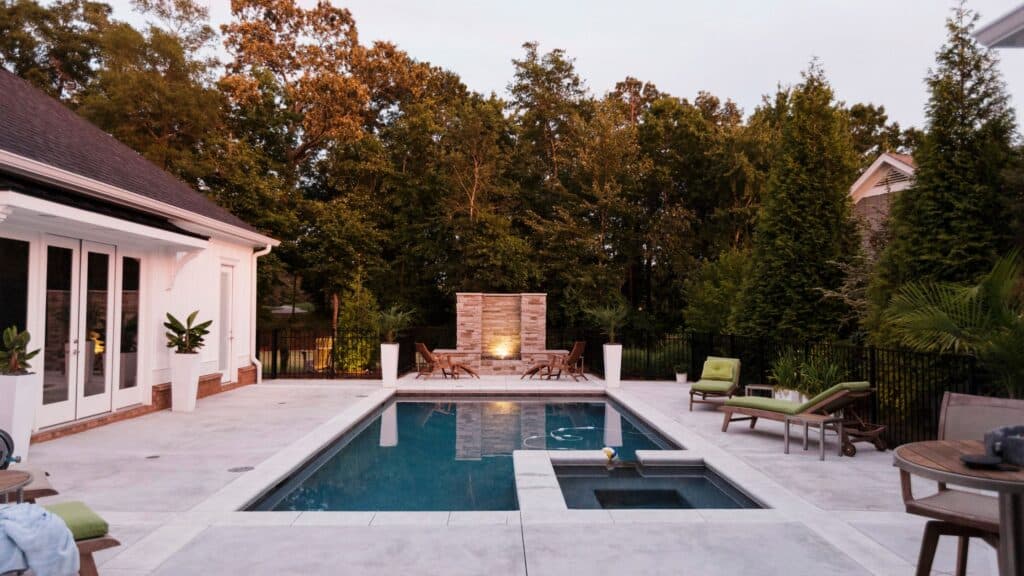In this article, we’ll cover everything you need to know about a concrete pool, including the advantages and disadvantages, cost, and how to build one.
Concrete pools are a popular alternative for homeowners who want to enjoy the luxury of a pool in their own backyard. Yet, installing a concrete pool takes careful planning and execution to ensure a long-lasting and practical design.
A reinforced concrete swimming pool is made of a reinforced iron frame that is filled with concrete. It is particularly resistant to terrain movement in this setting. In addition to having a strong structure, it can also add an intriguing and distinct appearance to the outdoor space. Do you want to learn more about the benefits and drawbacks of this valuable property component?
What Is A Concrete Pool?
Cement is a component of concrete, not the same substance, despite the fact that we often use the terms interchangeably. Concrete is a compound composed of water, cement, sand, and a coarse aggregate (stone or gravel). Spraying gunite or shotcrete creates a concrete pool shell. Shotcrete is already wet, whereas gunite is a dry mix with water in the sprayer.
If done correctly, these two procedures yield the same product and have no discernible difference in quality. It takes time for the concrete to attain its full capacity after it has been sprayed on and doesn’t really dry. It hardens and strengthens over time in a process known as curing. This takes roughly 28 days for a pool shell to be ready.
Concrete strength is measured in psi, or the pounds per square inch required to crush it. Concrete has an average strength of 3500-4000 psi.
The amount of cement added to the mix determines the strength of the concrete—the more cement used, the stronger the concrete (you may also be interested in checking out the concrete calculator for slab projects).
The aggregate (the rocks or gravel mixed in) has a very high compressive strength: crushing concrete requires a lot of pressure.
Yet, because concrete has a very low tensile strength (against a force that pushes it apart), bending or flexing it causes the force to pull on the surface and crack it. This can produce surface or structural cracks in concrete pools. It’s not ideal.
Pool builders mitigate this by encasing the concrete in a steel web. Steel and concrete combine to form a strong structure that can bend and flex in order to withstand the effects of water, earth, and gravity.
What Are The Pros And Cons Of A Concrete Pool?

Pros
Customizable
Concrete has the major advantage of being highly customizable. Concrete pools allow you to customize the size, form, and any other characteristics you desire. If you like, it could be in the shape of a car or even an airplane; this would be extremely expensive but perhaps feasible.
Durable
Concrete pools, like fiberglass pools, are extremely durable. Sharp items will not damage the pool structure, which is a disadvantage of vinyl liners. If you wish to swim with your dogs in the pool, their nails will not damage the concrete. As an aside, the plaster of the pool (the inside finish) is not as long-lasting as the concrete structure itself and must be refinished, which adds to the overall expense.
Pretty
Concrete is also visually appealing. Although “beautiful” isn’t the first word that springs to mind, concrete creates a classic pool aesthetic. There’s no need to be concerned about a liner bubbling or separating, and if you keep up with concrete pool cleaning, you may avoid the worst of discoloration and algae.
Cons
Long Startup Process
The beginning process for a concrete pool is lengthy. Recall that the curing process alone takes over a month, and there is much more to the construction process than that. Concrete pools take 3-6 months to install, as opposed to fiberglass and vinyl liner pools, which may be completed in a matter of weeks.
Rough Surface
A concrete pool’s inside is tough, but it’s also abrasive and can scrape your skin, especially in children. Even if you refinish the plaster on a regular basis, there isn’t much you can do about the texture.
High Concrete Pool Maintenance
Concrete pools have a greater lifetime cost (follow-up fees and maintenance) than vinyl liners or fiberglass pools. Concrete pools necessitate a significant amount of hands-on upkeep. Concrete’s porous nature allows algae to flourish.
Algae is particularly difficult to remove once it has become lodged in the surface of a concrete pool. Concrete pool builders actually advocate brushing the entire surface of the pool with a steel brush at least once a week to eliminate any algae that have accumulated on the surface.
While the majority of this normal maintenance does not require professional assistance, you will be responsible for it. Using a professional pool cleaning service, on the other hand, will save you time but not money.
Significant Time And Money
Another difficulty with concrete pools is water chemistry. When algae embed in the surface, more chemicals are required to reach and destroy it. Also, because concrete is alkaline, it constantly raises the pH of the pool water. To keep the water balanced, you must test it and add acid on a regular basis. The pool will require extra time and money to maintain.
Frequent Refinishing
Because concrete is incompatible with salt, dissolved salt in pool water will reduce the life expectancy of a concrete pool’s interior finish. As a result, you’ll need to refinish the plaster every 10-15 years, and you’ll need to engage an expert to do so.
Which pool is better, concrete or fiberglass?
Concrete pools are substantially more expensive to own in the long run than fiberglass or vinyl liner pools, especially when they have funky water features. Follow-up maintenance and expenses, such as acid washing by professionals every 3-5 years, more money spent on chemicals and energy, and refinishing/remodeling compound the initial cost.
Concrete Pool Construction – How To Build Concrete Pools

This procedure typically takes 3-6 months to install and start up a concrete pool.
1. Concrete Pool Excavation
The earth must be excavated and either hauled off-site or used on the property. This can take anywhere from a few hours to two days.
2. Steel Placement
You must weave together a cage of steel bars known as rebar before encasing it in the concrete shell. This produces a web of strength and aids in the prevention of structural breakdown. Recall that incorporating steel into concrete structures, such as swimming pools, increases the structure’s ability to bend and move in response to its surroundings. This period usually takes 1-2 days.
3. Concrete Pool Plumbing
Install the pipe needed to circulate the pool water before laying the concrete shell. The majority of this plumbing should be installed before the steel phase. However, some piping is supported by steel and is thus installed subsequently. During the concrete shell installation, you should cap and pressure test this plumbing. Before the concrete pool shell is installed, a piping and steel check is usually required. This stage takes 1-2 days.
4. Concrete Shell Placement
Using a nozzle, spray concrete (either gunite or shotcrete) into place, then shape it with straight edges and flat, round-edged trowels. You’ll be able to observe the pool take shape in 1-2 days.
5. 28-Day Cure Time
Curing is the process by which certain cement molecules get hydrated with water. The strength of the concrete increases as it becomes more hydrated or cured. Relatively complete curing takes concrete 28 days.
6. Concrete Pool Waterproofing
The pool shell may be waterproofed by the builders. They smooth any uneven sections of the shell, carefully clean the surface, and apply the waterproofing material by spraying or rolling it on. This process takes 1-3 days.
7. Tile and Coping
Because the surface of a concrete pool is porous and will stain at the waterline, tile is required around the pool’s top 6 inches. Coping is the concrete or stone border that surrounds the pool and creates a transition from the pool to the patio. Both tile and coping are normally installed by the same team or contractor and might take anywhere from 3 days to 2 weeks.
8. Patio Installation
The builders prepare the foundation beneath the patio area by putting down and compacting stone, and then they install the patio in 1-2 weeks.
9. Concrete Pool Plaster
The internal surface of the concrete pool is applied during the final building phase. Plaster is often a mixture of cement, sand, marble dust, color, and water. It is pumped through a hose, sprayed onto the pool shell, and troweled to a flat surface by the constructors. Typically, the builders will finish this in one day.
10. Concrete Pool Start-Up
Every day, the builders—or, more often, you—check and balance the water chemistry. Brush the pool twice a day for the first 10 days after filling to remove plaster dust from the surface. Pool heaters should not be turned on until plaster dust has been removed. You should avoid using chlorine for at least 48 hours. The pool will be operational in 10 days.
What Does A Concrete Pool Cost?
A concrete pool can range in price from $50,000 to $100,000, depending on location, but it is not uncommon for them to cost more, especially with added landscaping and accessories. Maintenance during the life of the pool typically adds $20,000 or more to the initial cost. Several factors contribute to the upfront and lifetime costs of owning a concrete pool.
What Is the Difference Between Masonry and Concrete Pools?
The primary distinction between concrete and masonry pools is in their structural design. The first consists of connecting concrete to an iron frame, whereas the masonry building has a “simpler” structure. As a result, the concrete pool is more resistant, and it is recommended for the use of tiles, inserts, and ceramics because it will not leak.
Conclusion – Are Concrete Pools Good?
A concrete pool can add value and enjoyment to your home, but it’s important to carefully consider all aspects of the design and construction process. By understanding the benefits of concrete, working with experienced professionals, and taking the time to plan and execute your project properly, you can create a beautiful and functional pool that will bring years of enjoyment to you and your family. With the right knowledge and tools, building a concrete pool can be a rewarding and fulfilling DIY project.
